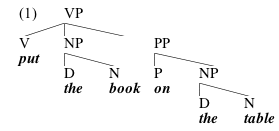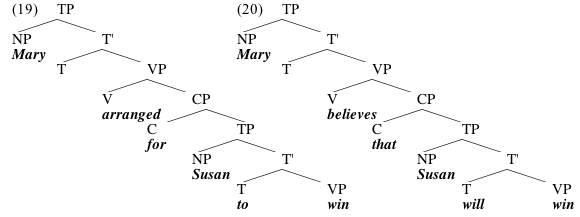
We've already seen that the verb put selects for two complements, an NP and a PP:

But in fact it's more specific than that. Only certain PPs can satisfy put's needs:
(2) John put [the book] [on the table]/[under the chair]/[in the fire]/[near the sofa]
(3) *John put [the book] [during the party]/[after the meeting]/[despite his misgivings]...
In fact, it looks like we need to be more specific; put actually needs a PP which describes a location. But having said that, it's not clear that we need to say that this complement of put needs to be a PP at all. Perhaps if we just say that one of put's complements is a location, the fact that it's a PP will follow; the semantics might be able to tell us that locations can be realized syntactically as PPs but not, for example, as VPs, or NPs.
Similarly, we've said that devour subcategorizes for an NP complement (or to put the same claim in more traditional terms, devour is an obligatorily transitive verb). But maybe if we fully understood the meaning of this verb, we wouldn't have to stipulate this; it would be part of the meaning of devour that there's some object getting devoured (an entity which undergoes this type of change of state as a result of the action described by a verb is sometimes called the Patient), and it would be the job of the semantics to tell us that although the kinds of things referred to be NPs can be devoured, the kinds of meanings associated with clauses, VPs, APs, PPs, etc. cannot be. In other words, once we fully specify the meaning of devour, we might not need to bother stipulating that its complement must be an NP.
We've arrived, then, at a question about how much of selection is syntactic, and how much of it is semantic. These two imaginable types of selection have names; syntactic selection, for things like PP, NP, etc., is called c-selection (for "category selection"), and semantic selection, for things like Patient, Location, etc., is called s-selection (for "semantic selection"). So the question before us is whether we want to describe selection as c-selection, s-selection, or some kind of mix of both.
| Optional Reading: one classic paper on the contrast between c-selection and s-selection is this one by Grimshaw. Because this is an older paper, some of the terminology is different from what we're used to; in particular, she refers to c-selection as "subcategorization" and to s-selection as "complement selection", and she also uses S and S' for what we're calling TP and CP. |
We've already seen that it's probably hopeless to try to do everything with syntactic selection; unless we want to assign different syntactic labels to locative PPs and other PPs, we apparently need to be willing to refer to semantics in order to correctly capture the selectional properties of a word like put, for example. On the other hand, there do seem to be some kinds of facts that look irreducibly syntactic. The two sentences below, for example, seem to mean the same thing, more or less:
(4) John asked what time it was.
(5) John inquired what time it was.
If we are trying to do everything by s-selection, we will want to say that these verbs select for some type of semantic object (call it a Question), and that that semantic object can get realized as a clause.
The problem is that the selectional requirements of these verbs are not the same, as we can see in (6) and (7):
(6) John asked the time.
(7) *John inquired the time.
So we have a real problem here, if we're trying to make all selection into s-selection. Both of these verbs s-select for Questions, and we saw in (4-5) that Questions may be realized as clauses. How else can Questions be realized syntactically? Well, in (6-7) we are getting conflicting answers to that question; (6) makes it look like a Question can be an NP, while (7) makes it look like it can't. Apparently we need to be willing to make use not only of s-selectional information (like "this verb selects for a Question") but also of c-selectional information (like "this verb selects for an NP").
Finally, we can also be a little more specific about the structural conditions on selection. We've already observed informally that selection seems to be restricted to sisters; that's why selected phrases are complements of the head (in other words, obligatory sisters) rather than adjuncts. Now, consider the following instances of selection:
(8) The peasants depend on/*from/*by/*near the king.
(9) John is fond of /*at/*by/*from Syntax.
It often seems to be the case that selection is not just for a sister of a particular category with a particular semantics, but for a particular head. A verb like depend, for example, selects specifically for a PP headed by on; the other parts of the PP (that is, the complement NP of the P) are irrelevant for selection. So it seems to be the head of the complement that gets its properties fixed by selection. We don't find, for instance, verbs which select for PP's with particular NP complements. There is, for example, no verb schmepend, which is like depend in selecting for a PP complement, but unlike depend in that although the P can be anything, the NP complement of the P must be artichokes:
(10) John schmepends near/on/at/to/by/despite artichokes/*rutabagas/*students.
We never find verbs like this. So it looks like selection is specifically for the head of the sister. We can formalize this as the Projection Principle, which will state that:
Projection Principle
If a head X selects for an element Y, Y must be the head of the sister of X.
The Projection Principle will guarantee something that we observed informally a while ago, namely that selected phrases are always complements--that is, sisters of the selecting head.
The Projection Principle is a way for us to handle the observation that some verbs, for example, are picky about the prepositions that can be the heads of their complement PPs. And in general, when we see this kind of pickiness, we're going to be tempted to attribute it to selection; we'll suspect that when one word seems to impose requirements on the form of another word, the first word is selecting for a phrase of which the second word is the head. In other words, we can use the properties of selection as a test, helping us to understand structures which we haven't yet been able to figure out.
For instance, we haven't yet discussed data like the ones below. Consider, in particular, the distribution of the underlined words:
(11) Mary arranged for Susan to win.
(12) Mary believes that Susan will win.
(13) *Mary arranged that Susan will win.
(14) *Mary believes for Susan to win.
As you can see, the underlined word has its form determined partly by the preceding verb; when the verb is arranged, the underlined word seems to need to be for, while the verb believed is followed by that. Here we have a type of pickiness of the type we associate with selection; since the verb appears to determine the form of the underlined word, we'll conclude that the underlined word heads a phrase which is the complement of the verb in these examples. These underlined words are called complementizers, and are taken to head a phrase CP (that is, "complementizer phrase"); in these examples, the verbs arranged and believes are taking CP complements.
In fact, the data in (11-14) demonstrate at least one other selectional relation between heads. Consider (15-18), again concentrating on the underlined words:
(15) Mary arranged for Susan to win.
(16) Mary believes that Susan will win.
(17) *Mary believes that Susan to win.
(18) *Mary arranged for Susan will win.
Here we have another selectional relation, this one involving the head we've been calling T, which can be realized as will (and also, we see here, as to). The choice between will and to appears to be determined by properties of the new head C; if C is that, then you can have will in T, but if C is for, you must have to in T. We thus arrive at the conclusion that C selects for T, and that TP is the sister of C:
